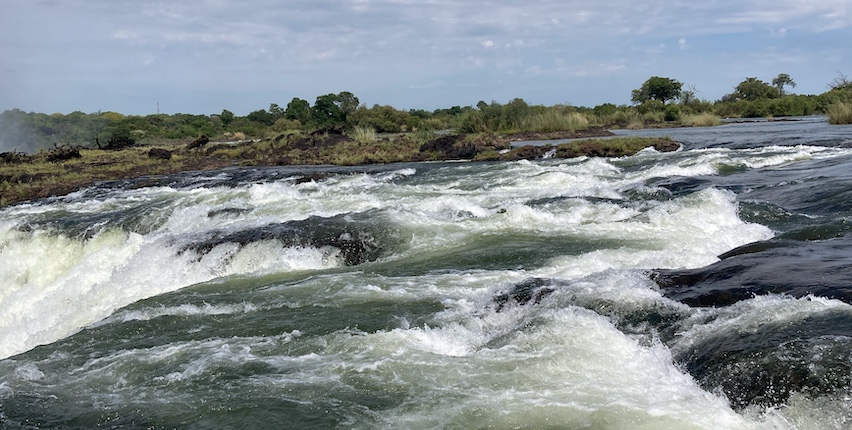
Victoria Falls viewed from the Devil’s Pool shows why nobody shoots these falls in a barrel. Photo by Mark Orwoll.
His wife suggested he take a long hike. Facing a milestone birthday, he decided to drive across Africa instead
By Mark Orwoll
Eight nervous travelers linked hands to form a human chain, then waded across the Zambezi to the edge of 350-foot-high Victoria Falls.
“I don’t want to do this,” said Sophie from Scotland, clasping desperately to my hand. “Don’t let go!”
With the mist from the thunderous cascade in our faces and the roar in our ears, we clambered onto an outcrop and edged our way to a hot-tub-size eddy at the lip of the falls called the Devil’s Pool.
Travelers who come here chicken out all the time. There’s no shame in it. A swim in the Devil’s Pool means standing within 12 inches of certain doom while staring into the abyss. One of our two guides scanned our group, then locked his eyes with mine. He motioned for me to jump into the pool and swim in his direction.
As I hopped into the water, I thought it might be the last conscious moment of my life.
No Way, You’re Not Going to Africa
You can imagine the scene when I told Kathy that I planned to celebrate a big birthday by driving across Africa, solo, to look for adventure.
“You’ll be kidnapped!” said my wife. “I know you! You’ll do something stupid. You’ll get killed in the jungle.”
Nonetheless, and with only minor long-term damage to my marriage, I flew to Windhoek, Namibia, on the day after my birthday. My goal, with the assistance of custom tour operator Audley Travel, was to drive halfway across the continent, some 1,200 miles, to Victoria Falls in Zambia. The question everyone asked me before leaving: Why?
The answer was simple. Getting older is better than the alternative, but not something most of us look forward to. More aches and pains, forgetfulness, a reluctance to take risks—the downside of aging is pretty clear. But I was still fit. I took no medications, my health was good, and the prospect of new adventures still excited me. Would I feel that way in five years? In 10 years? Maybe not. An inch of gold can’t buy an inch of time. If I didn’t do it now, I might never.
Only Food Runs
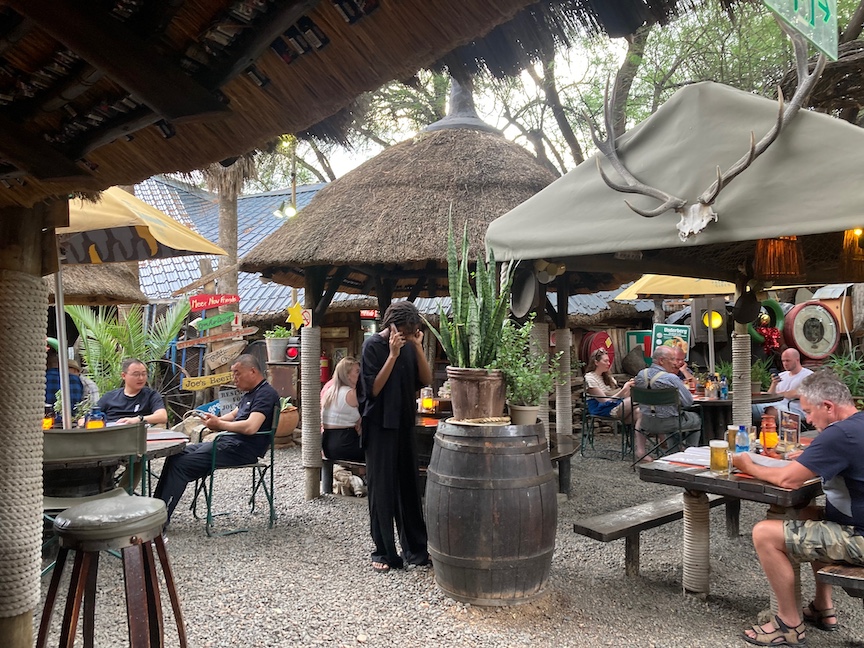
Joe’s Beerhouse in Windhoek provides a welcoming introduction to Namibia. Photo by Mark Orwoll
Every Namibian adventure should kick off with a night at Joe’s Beerhouse in Windhoek. It’s set up like a Namibian bush village, with round thatched roofs protecting the bars and outdoor dining tables from the occasional rainstorm. World travelers from all over—Chinese, Aussies, Dutch, locals—were enjoying bottles of Tafel and Windhoek lager and laughing with one another as bartenders set glowing lanterns on the bars and tables at dusk. Joe’s Beerhouse is more outside than inside, and completely walled off from the rest of the world. Tattooed backpackers were everywhere, along with old African hands, European businessmen making deals, and middle-aged Western travelers about to set off on their first safari.
I had little chance to hang out in Windhoek, the capital, because I was leaving first thing in the morning. But as I drove out of town, I saw the low-rise city, a little scruffy, on the edge of the great Namib Desert.
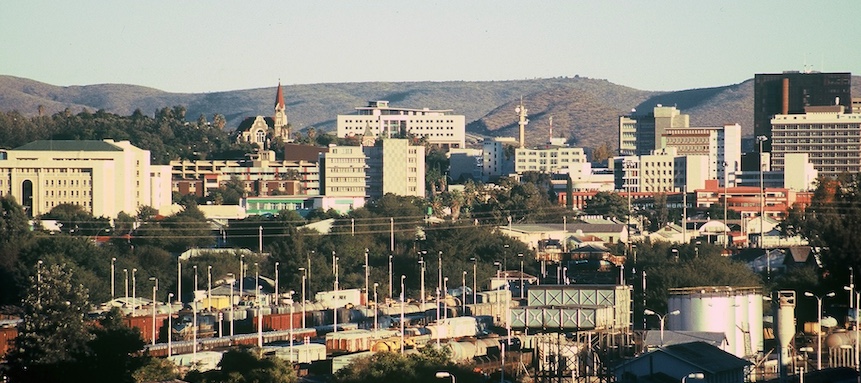
Windhoek, Namibia skyline. Photo by Bries, Wikimediacommons.org
My ultimate destination in Namibia was the remote Zambezi Region, called the Caprivi Strip, in the far northeast. Unlike the dry red deserts to the south and the famous sand dunes of Namibia’s Skeleton Coast, the Caprivi is thick with vine-draped jungle, marshes, teak and rosewood forests, and subsistence-farm fields, all fed by the Kavango, Zambezi, and Chobe river system. Thirty years ago, the narrow, 300-mile-long Strip was a hotbed of smuggling, poaching, and revolution. Today the region is safe. Tourism is growing. Wildlife flourishes.
The 5-star Onguma Camp Kala, my first overnight stop, was halfway to the Strip. There I met Frans Eiseb, my guide for a bushwalk. (Guides in Namibia must be trained, then licensed by the Ministry of Environment.) As we prepared to march into the woodlands of the surrounding Onguma Private Reserve, I saw that Frans held a rifle. He casually loaded five .550-magnum cartridges, each the size of my index finger, into the weapon’s chamber.
“Is that necessary?” I asked.
“It’s for your safety,” he said with a no-nonsense glare. “And mine.”
We began to trudge away, but Frans stopped again, with a word of advice.
“If we see anything dangerous, unless I tell you, just stand your ground,” he said. “Remember: Only food runs.”
Then he turned back to the trail and forged ahead.
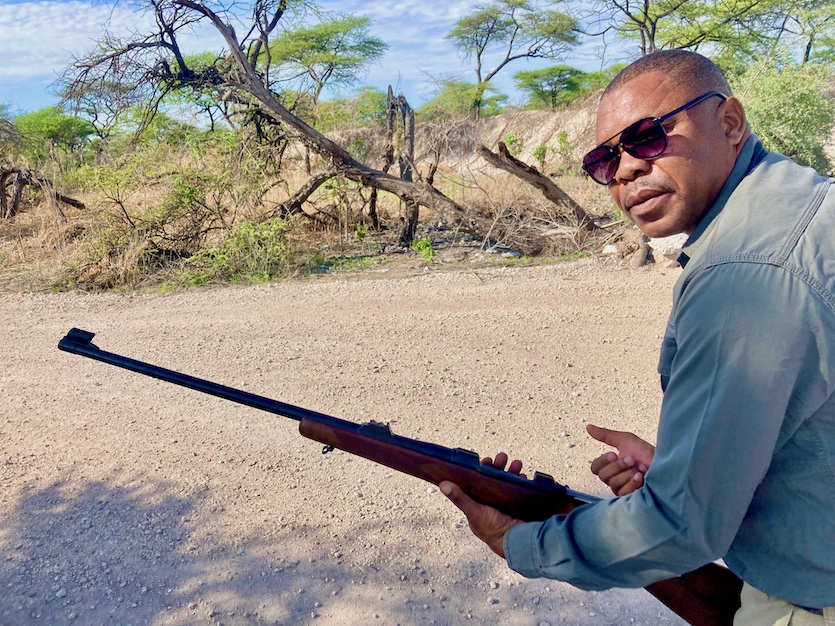
Frans Eiseb takes tourists on bushwalks through the Onguma Private Reserve in Namibia. He carries a rifle to let foraging wildlife know that his human charges are not on the menu. Photo by Mark Orwoll
A Newbie in the Bush
Deep in the savanna, full of acacia trees and makalani palms, I realized I must have cut myself. Dark-brown stains spread across the front of my shirt. Was I bleeding? Would I get a tropical infection?
“I think you spilled coffee at breakfast,” Frans said, then turned back to the trail.
Despite my safari hat, tropical-weight shirt with flaps and straps, and pants that could zip off at the knees, Frans seemed unimpressed by my bush smarts.
On that morning’s walk and on a jeep excursion that afternoon, we spotted Angolan giraffes, blackface impalas, plains zebras, elephants, kudus, and a female lion making a deposit into the Great Bank of Nature. The only close call we had was on a game drive in nearby Etosha National Park. Frans spotted two rare black rhinos, a female and calf. As we watched them graze, a hyena came into view. The rhinos made a false charge, sending the hyena racing into the dry thorn scrub.
“The female has been dehorned,” explained Frans. “Unfortunately, it’s the only way to save them from poaching.”
The rhinos wandered out of sight, only to appear unexpectedly on a rise 20 feet from us. They ambled in our direction. Frans turned off the engine. Soon they were within 10 feet.
“Hey, Frans,” I whispered, “shouldn’t we put the engine on so we can drive away if they attack us?”
“They won’t charge us,” he said. “They’re just curious about what this vehicle is.”
Suddenly, the poor-sighted rhinos caught our scent and, as if finding it repulsive, trotted away.
“They don’t want anything to do with us,” said Frans.
Mean Man at the Shebeen
On the road to my next camp, near Rundu at the Angolan frontier, the temperature reached almost 100 degrees. I prefer open windows to A/C, and the heat was getting to me. A lone pink building looked like a tavern, which they call a shebeen in Namibia. I pulled into the hot, dusty lot and walked inside. The bar had a cage around it. Five women between 18 and 50 and a teenage boy were seated there. The women giggled and took sneak peeks at me. I asked the teenage girl behind the counter for a beer, and she handed me a cold quart of Windhoek lager. “Twenty-five dollars,” she said (about U.S. $1.30).
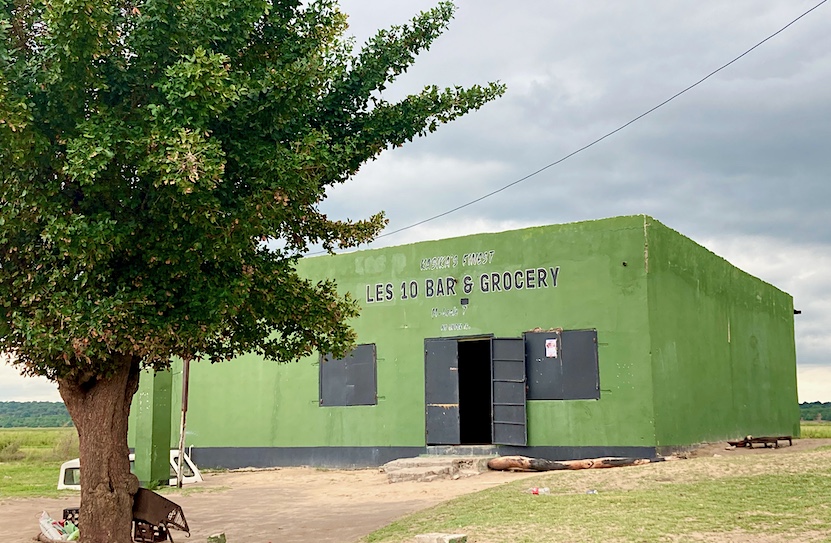
Typical shebeen, outside Kasika. A simple, cost-efficient place to buy junk food and cold beer. Mean guys are not readily available. Photo by Mark Orwoll
The shebeen had a cement floor, a high ceiling, bare walls, a pool table in the corner, and an electronic gambling machine that flashed multicolored lights and emitted war whoops, even though no one was playing it. But the large beer was cold and the shadowy interior was cool. A good place to stop—until the man walked in.
He was in his early thirties. He stood right in front of me in a challenging way and said, “I’m thirsty.”
“Well, great,” I said. “You came to the right place.”
He said, “I’m thirsty for you to buy me a beer.”
Man, this is not what I need.
“No,” I said, “I’m not going to do that, friend.”
“You better buy me a beer. I’m mean!”
He was taller, younger, and meatier than me, but he didn’t look physically fit. I wondered if he was mentally ill. I walked away from him and stood in the doorway.
Outside, there were some people sitting under the shebeen’s awning. They looked like locals, at ease with each other, mostly in their twenties and thirties.
One woman turned to me and said, “I’ll go with you. You give me a job. I need money to buy Christmas presents.”
“Yeah, well, I don’t have any work for you,” I answered.
Another woman at the same table said, “You give me a lift up to….” She named some village up the road that I didn’t catch. I said, “Nope, no can do.” Then I turned away.
Back inside, I asked the bartender for a plastic cup. I poured out about six ounces of beer and handed it to Mean Guy. I finished my drink and got the hell out of the shebeen.
Not A Disney Movie
The best game lodges work closely with local villages. They fund water projects, employ the area residents and much more. Most lodges encourage guests to visit the local communities. Those who do learn firsthand that Africa isn’t a Disney movie with cute animals, but a land with history, tradition, tribal disputes, in short, everything you’ll find in your hometown.
No one knows that better than Swiss couple Chris and Pascale Haefeli, who took over the small, off-the-grid RiverDance Lodge near Divundu in 2018 on land leased from a local village whose Bantu-speaking residents fish in the Kavango and raise millet, maize and cattle as their main income source.
“I was a manager in a global food company,” said Chris. “I’d had enough of my corporate life and wanted to do something completely different. I had no experience in hospitality, and my wife is a kindergarten teacher. So, the first six months here were…a bit tough. I thought, What the hell am I doing here?!”
The Haefelis wanted their lodge to have as little impact on the environment as possible. “You see how it’s built,” he said, looking around. “It’s well integrated into nature. You have the bush all around you. Like this tree here,” he said, smiling and pointing to a mature tree that was growing through a hole cut into the restaurant’s wooden deck. “The guests here really have the feeling of the African bush.”
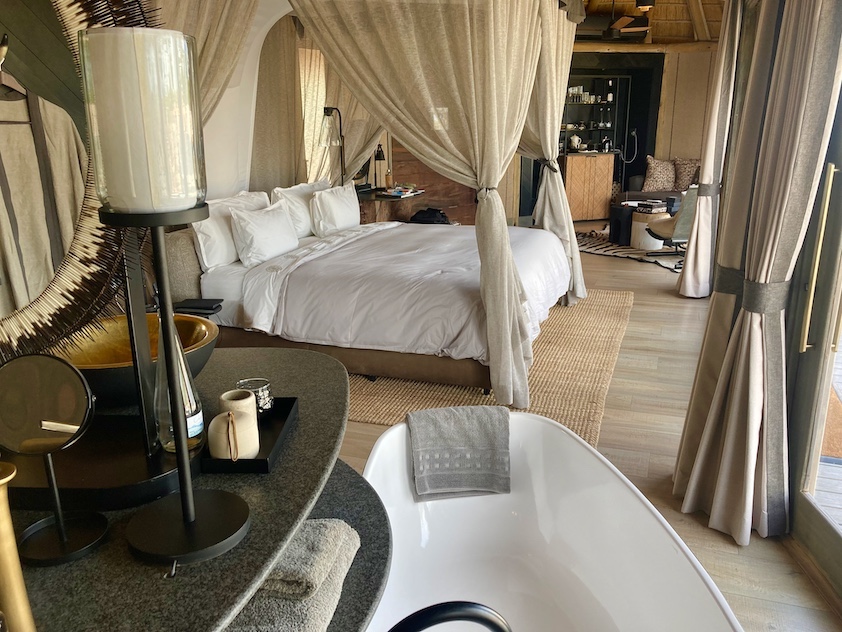
Guest chalet interior at the 5-star Onguma Camp in Kala. Photo by Mark Orwoll
The lodge has a casual, even raffish air, with gravel paths winding through the surrounding overgrown greenery. Seven bungalows, each with a balcony and a bathtub with Kavango views, seem as if they might be devoured at any minute by the riverine jungle. Shy smiles from the staff greet guests on their way to sundowners on the restaurant deck or as they head to the riverfront for an evening cruise on the camp’s flat-bottom, tent-roofed motorboat. The mood is unhurried, nonjudgmental, the sort of place where no one looks at you sideways if you decide to have your first glass of wine at 11:30.
Chris and Pascale’s relationship with the nearby villages is a close one. “We don’t have employees from anywhere else. Just from around here,” he said, casually waving an arm to indicate the surrounding area. “We have about twenty-eight staff, all from these villages.”
They immediately made community projects part of their mission.
“We focus on education and water projects,” Chris told me over a glass of dry Cabernet on a wet evening. We were seated on the lodge’s dining deck that looked out on the Kavango River. Angola, dark and jungly on the opposite bank, appeared close enough to hit with a rock. Angolans frequently wade across the Kavango for school, employment, shopping, and medical care in the more prosperous Namibia.
“We support the school here very much. When we came here six years ago there were 300 kids. Now there are 600. Imagine!” Chris shook his head in subtle amazement.
“We built a kitchen for them and a kindergarten. Now we’re building a toilet station with flushing toilets. We drilled the borehole for them, so they have clean water in the school. And so, we continue…. Small things, bigger things.”
We Have Nothing for Eyes
Later, I went to Ijambwe, population 90 (55 adults, 35 children), an outwardly primitive yet relatively prosperous hamlet a mile from another safari camp, Serondela Lodge in the eastern Caprivi. A villager named Joseph Siyeta, a net fisherman and cattle owner who, because of his English skills, also leads village tours, was eager to show me around. As we walked along the sandy soil of the mud-hut community, he pointed out the trees they had planted for medicine.
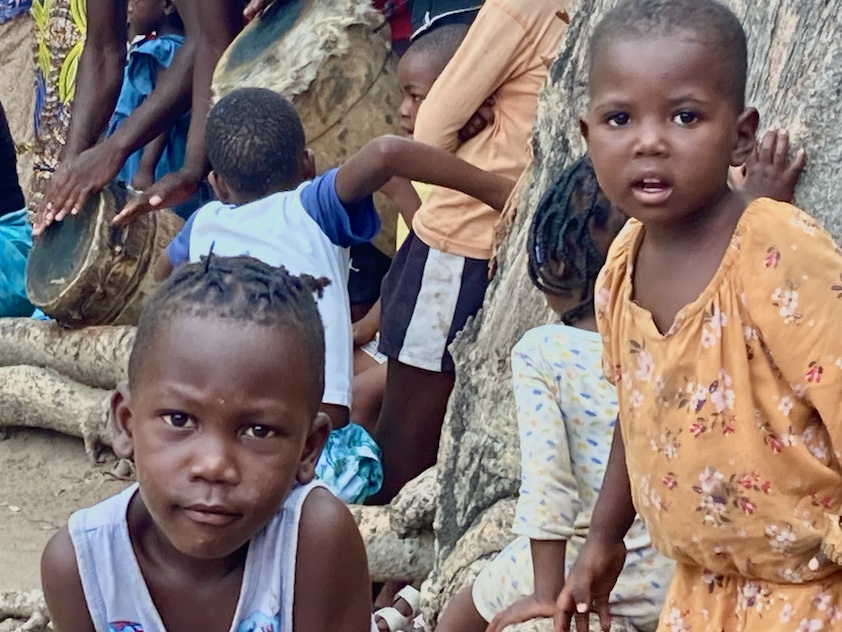
Children at a celebration in Ijambwe. Photo by Mark Orwoll
“We use the leaves of the moringa tree if we have high blood pressure,” he said. “We make the leaves into a tea and the blood pressure goes down. And this is a gum tree. We use the leaves for coughs and stings.”
Then he nodded toward the community’s new well, solar-powered pump, and water tank.
“The river is full of crocodiles, so five years back we built a borehole [a well] and a solar panel to pump the water to a tank,” he said proudly. “We have three taps in our village now. Our women are very happy. They no longer have to worry about crocodiles on the riverbank when they collect water.”
He pointed toward a small mud-and-stick building still under construction. “We will soon have toilets that flush. We won’t have to use the bush toilet.” A medical clinic and modern school were just two miles away.
Not every settlement is as fortunate. During a brief stay at Nkasa Lupala Tented Lodge, I asked owner Simone Micheletti (who also owns Serondela Lodge near the Zambian border) for any recommendations about things to do. He suggested a visit to Sangwali, in an isolated corner of the Caprivi Strip.
The spread-out village, well off the main highway, looked to be prosperous when I arrived, if only because there were electric wires and cars parked next to the boma-enclosed mud houses. While there, I visited the village health clinic. People with medical complaints filled the lobby and the overflow waiting area outside.
“We have no doctors here,” Nanvula Sikubi, an assistant nurse, told me. “Only nurses. We need a laboratory and X-ray machines. We have only one blood pressure machine. We have only one thermometer. We don’t have dentistry. We have nothing for eyes, either.”
A Mishap on the Chobe
Serondela Lodge, whose modernist architecture belies its award-winning eco-conscious approach to tourism, overlooks the Chobe River in the remote, far eastern end of the Caprivi Strip. Seasonal flooding from January through August causes the lodge to become an island, reachable only by boat.
By now, I’d been on the road for nine days and had driven more than 1,000 miles. Frankly, I was getting tired. Lacking road access, I would have to reach Serondela, my next stop, by driving my Toyota Hilux 4×4 out of Namibia to the small river port of Kasane, Botswana, to board a skiff that would ferry me to the lodge back in Namibia. The detour through Botswana proved to be unforgettable.
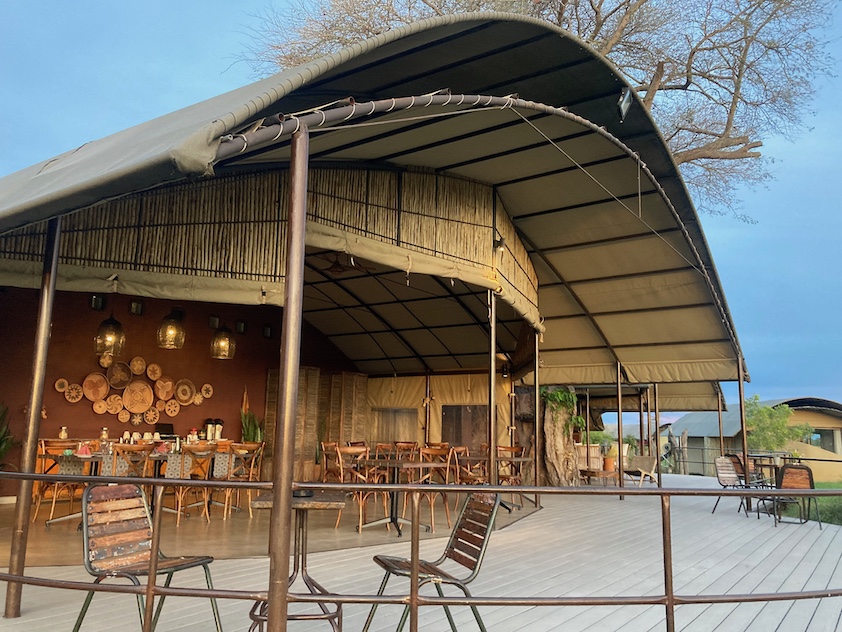
The open-walled bar and lounge at Serondela Lodge. Photo by Mark Orwoll
On my way to Kasane, I drove through Chobe National Park. A party of seven elephants, including two calves, lingered in the road until they heard my approach. The sight of them was almost an out-of-body experience for me. Elephants! In the middle of the road!
A pack of baboons, perhaps 20 of them, ran right in front of my car, forcing me to brake hard, even as my heart was racing. Baboons struck me as messy and menacing; I was glad to see them run off into the bush. A lone giraffe contemplated the occasional vehicle on the highway, and not far away a Cape buffalo (one of Africa’s Big Five) grazed at the edge of the road.
I wanted to do nothing more than pull to the wayside and absorb the wondrousness of it all. Frequent road signs, though, warned against it, lest some animal take your presence as an invitation.
This northern section of Botswana, at the edge of the Okavango Delta, is one of the most wildlife-rich regions in Africa. In physical appearance, it differed little from Namibia on the opposite bank. Unlike in Namibia, though, I found government officials and local police to be rude, cocky and poorly uniformed.
An hour later I arrived in Kasane, where Benito Siyeta, my boat driver from Serondela Lodge, was waiting. We crossed the Chobe to clear immigration on the Namibian side. There was no pier, so I was obliged to hop on a raised platform at the fore of the metal boat before jumping onto solid ground. But I misjudged the platform and came crashing down, leaving a gash in my left leg and a twisted ankle. The ankle quickly began to swell as my shin bled freely. I managed to climb out of the boat and tried not to limp.
When I returned with my newly stamped passport, Benito told me the ride to Serondela would be about an hour on the water. Good thing I bought a quart bottle of the local Tafel lager for the ride.
Two days later, I would be in Zambia, with a side trip to Zimbabwe. The entire ZimZamBotNam area around the Zambezi River is much the same: rivers, jungles, wildlife, villages of thatched-roof rondavels. The key differences that I saw had more to do with the people and the bureaucrats than with landscape or animal life. In that regard, Namibia had some of the most gracious, kind, and sweet-hearted people I’ve met, even including cops at the frequent highway checkpoints. The other places? Not so much.
Africa Can Kill You
I didn’t die in Africa, though I felt that I might a few times. Once with the black rhinos in Etosha. Again in Nkasa Lupala Tented Lodge, a Hemingwayesque tented safari camp, when guide Justin Simataa and I, in an open-sided 4×4, came within five feet of two male lions. They weren’t happy and began to roar.
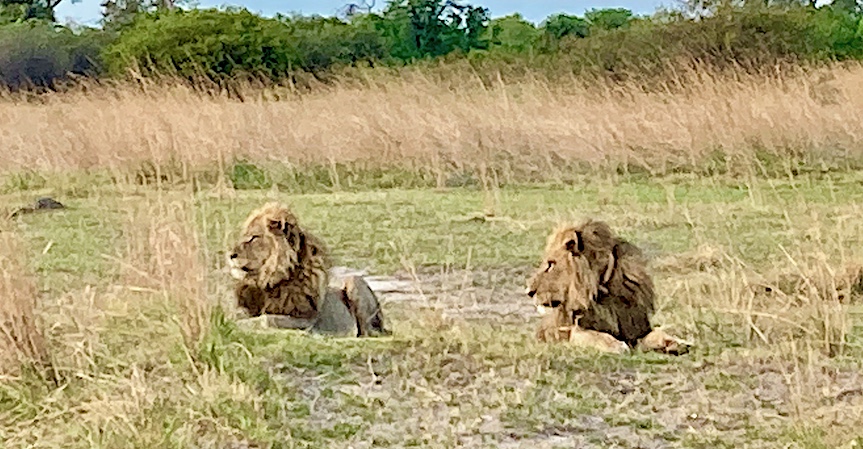
Two brother lions outside Nkasa Lupala Tented Lodge. Photo by Mark Orwoll
“They’re calling for their brother,” said Justin.
“You mean, there’s more of them?!” I squeaked.
At Serondela Lodge, while on a sundowner cruise with general manager Simone Micheletti, we idled within 10 yards of an elephant herd. A massive matriarch aggressively pushed her way to the front, aiming directly for us. She stopped, then took three challenging steps in our direction. Benito, our driver, reversed the engine and slowly backed away.
The most nerve-wracking animal encounter of my entire two-week trip came after leaving the village of Ijambwe on a motorized skiff piloted by our skillful driver, Ryno Kabuku. Returning to the lodge, we happened on a pod of 40 or 50 hippos cooling themselves in the shallows of the Chobe. One particular hippo paid suspiciously close attention to us, even though we were 50 feet away and not moving. He submerged and was out of sight until a minute later. The hippo broke the surface with a horrible grunting noise, inches from our outboard motor.
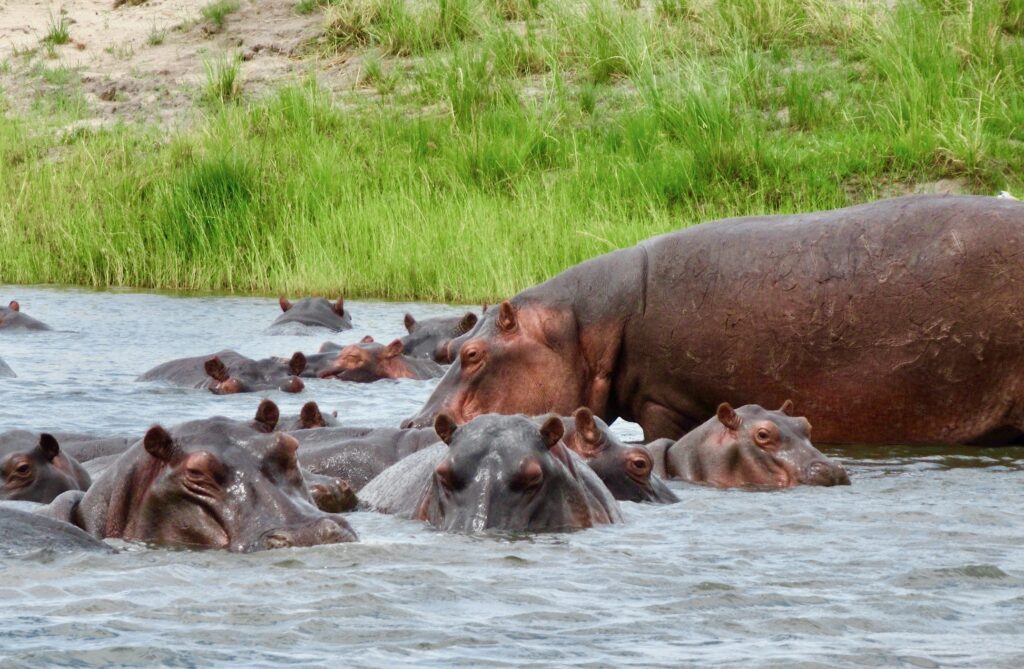
A pod of hippos near Ijambwe can pose a threat if you get too close. Hippos can kill. Photo by Mark Orwoll
A hippo will bite you in half. Apart from humans and mosquitos, they are responsible for more deaths in Africa than any other creature. And this was one angry hippo.
Ryno immediately pulled away at full speed from the attacking beast. I didn’t (or couldn’t) speak for five minutes.
Taking the Plunge
By far the greatest scare, near the end of my trip, was leaping into the Devil’s Pool above Victoria Falls. When I jumped from my rocky perch into the pool, I was surprised to find the river’s current strong enough to carry me involuntarily to the outer edge, where a wall of rock, barely below the surface, prevented me from spilling over the rim and into the depths beyond.
“Now lie on top of the rock,” said the guide. “Get as close to the edge as you can, close enough that you can see the bottom of the falls. I’ll hold your feet.”
Cautiously, I did a plank over the ledge. True to his word, the guide took firm hold of my ankles.
“Pretend you’re Superman,” he shouted over the roaring waters.
Afterward, I was able to propel myself out of the pool without trouble. I asked if I could swim to our starting point rather than use the safety rope that stretched across the river.
“Yes, you can,” said the guide. “You must swim upstream, at an angle, in that direction. When you reach those rapids there,” he pointed to some Class 1 whitewater about 20 yards away, “let the river carry you back to where we began.”
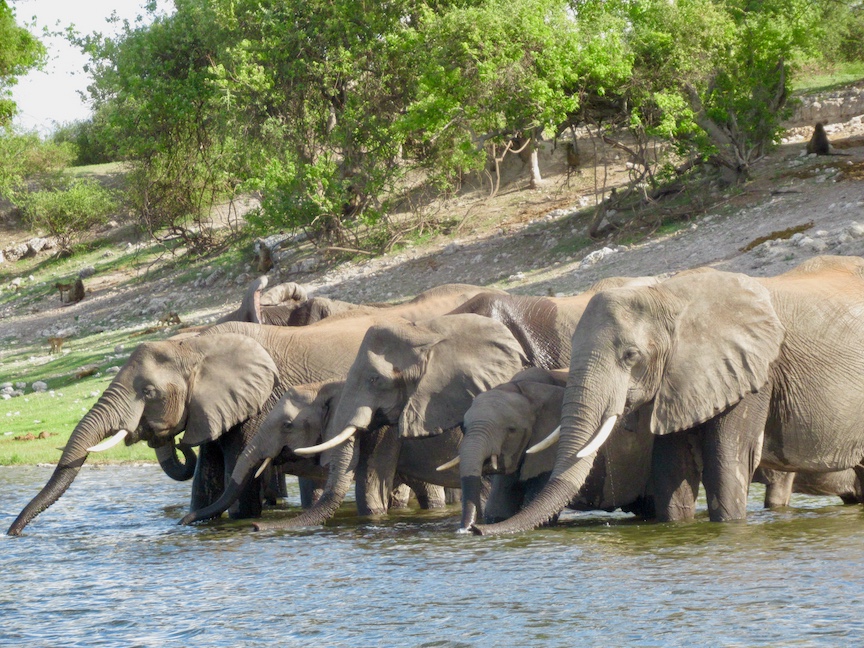
An extended family of elephants on the Chobe River, near Serondela Lodge. Photo by Mark Orwoll
Swimming the Zambezi would be icing on the cake. My memories of Africa continue to unfold, unceasingly, with blazing clarity. I can’t forget the first time I saw a baby elephant, attempting to bathe itself at a watering hole in Etosha National Park and looking up at its nearby mother as if to ask, “Am I doing it right?” The roaring of a lion, just outside my luxury chalet at Onguma Camp Kala, is with me months later. I think of Ijambwe, and wonder if I should do something, contribute something, toward the completion of their flush toilets. And I don’t even have bad feelings about Mean Guy. He just wanted a beer on a hundred-degree afternoon.
But all these recollections, refined and airbrushed by my memory, would come later. At that moment, as I was ready to leap into the Devil’s Pool, an old man with fire in his belly, I thought I would never die. Nothing can kill me now, I thought, balancing on the edge of Victoria Falls. Nothing can kill me.![]()
Mark Orwoll is a frequent contributor to East-West News Service. Besides his travel writing, he is the author of a thriller, Cross Purposes, and a film book, John Wayne Speaks.

